Yellowstone in September is a great time to visit; the falls, geysers, wildlife, and other sights are there, but with smaller crowds and lighter traffic.
Start planning your adventure to Yellowstone with the following information and tips. This article covers these subjects and more:
- Reasons to visit in September
- More reasons to visit Yellowstone
- Why visit the Northern Range — the American Serengeti
- Wildlife sightings
- All about Mammoth Hot Springs
- Best time to visit Yellowstone
- Where we ate and stayed

Top 6 Reasons to Visit Yellowstone in September
- Fewer people
- Lighter traffic
- Bugling elk during fall rutting season
- Easier parking (although the lot was full at Prismatic Springs)
- More hotel and restaurant options. Without reservations, we got a room at the Super 8 Hotel and dinner at The Raven Grill in Gardiner
- Better chance of getting a campsite in first-come, first serve campgrounds, and after Labor Day, the stay limit is 30-days instead of 14-days .
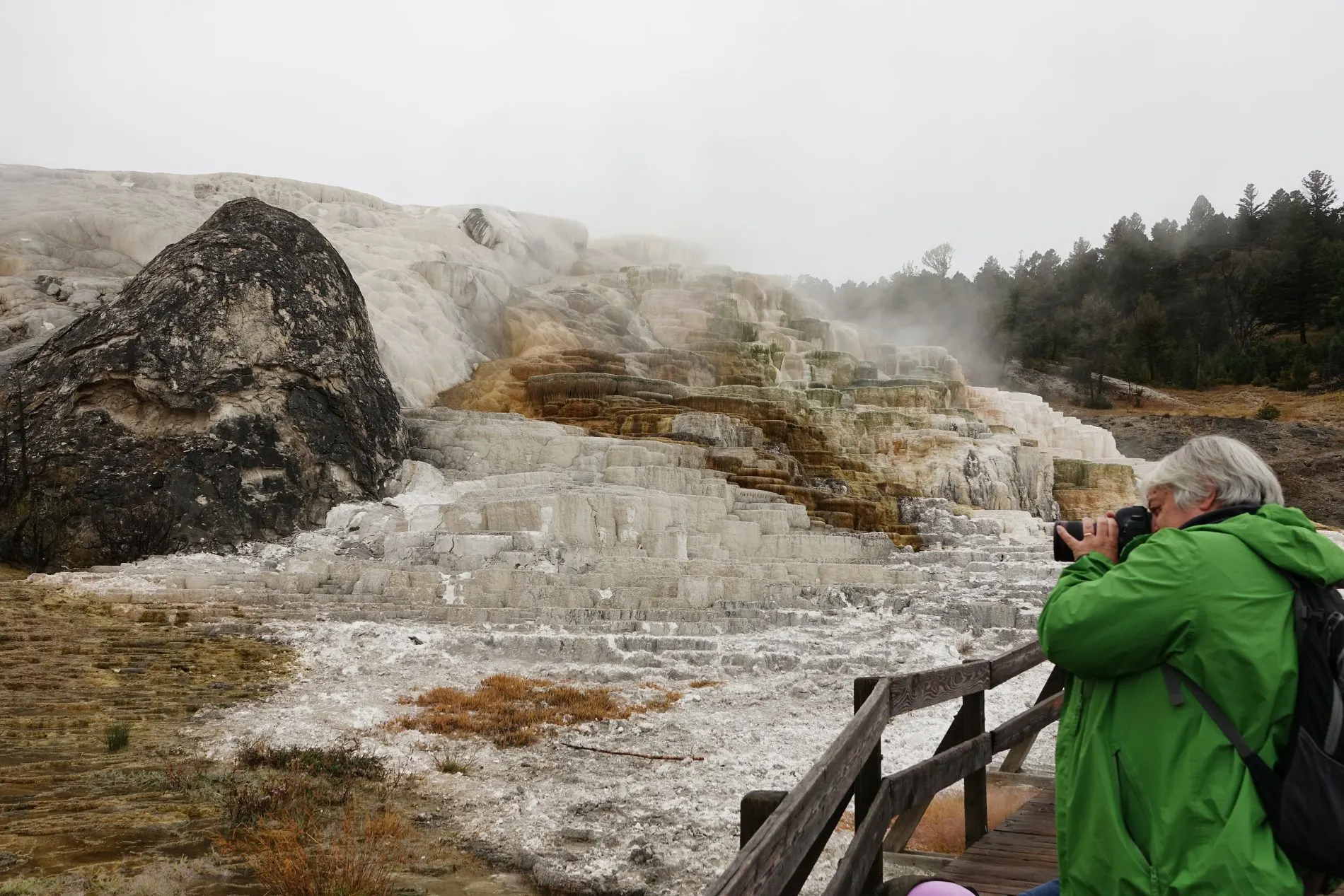
Reasons to Go to Yellowstone Anytime
There is so much to see, do and learn in Yellowstone, it’s little wonder it’s one of the most visited national parks in the US. It has:
- Hydrothermal features (including geysers, hot springs, and mud pots)
- Wildlife viewing galore
- Waterfalls and lakes
- Geology (shaped by volcanos and glaciers)
- History (including 50-million-year-old fossils dating back to the Eocene epoch)
- Hiking and Fishing
- Photography and videography
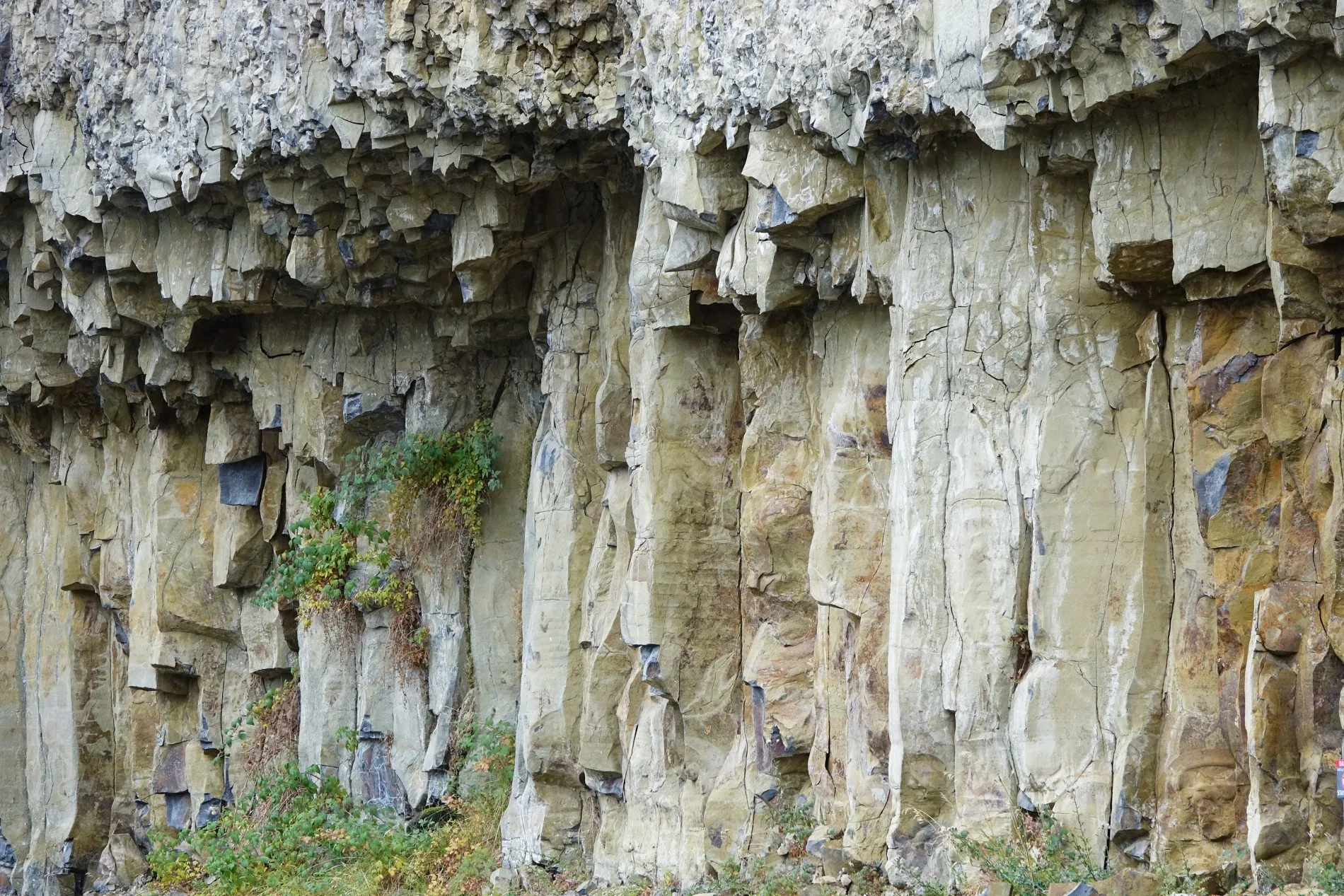
Is Yellowstone in September a good Idea?
Absolutely! Most of Yellowstone’s 4.1 million annual visitors are there in June through August, when good weather is more certain. In September, it’s much less crowded and easier to drive, park, find lodging, and see the sights.
After our week of exploring southeastern Montana, a quick trip to Yellowstone is just what we needed. We’ve both been to Yellowstone before, so we focused on the northern part of the park. It was great, but two-days was not enough. We didn’t see and do all that we wanted.
We had some rain and light snow, but the snow was only sticking to the mountaintops and not the road. Snow on the mountains and trees adds to the already gorgeous scenery.
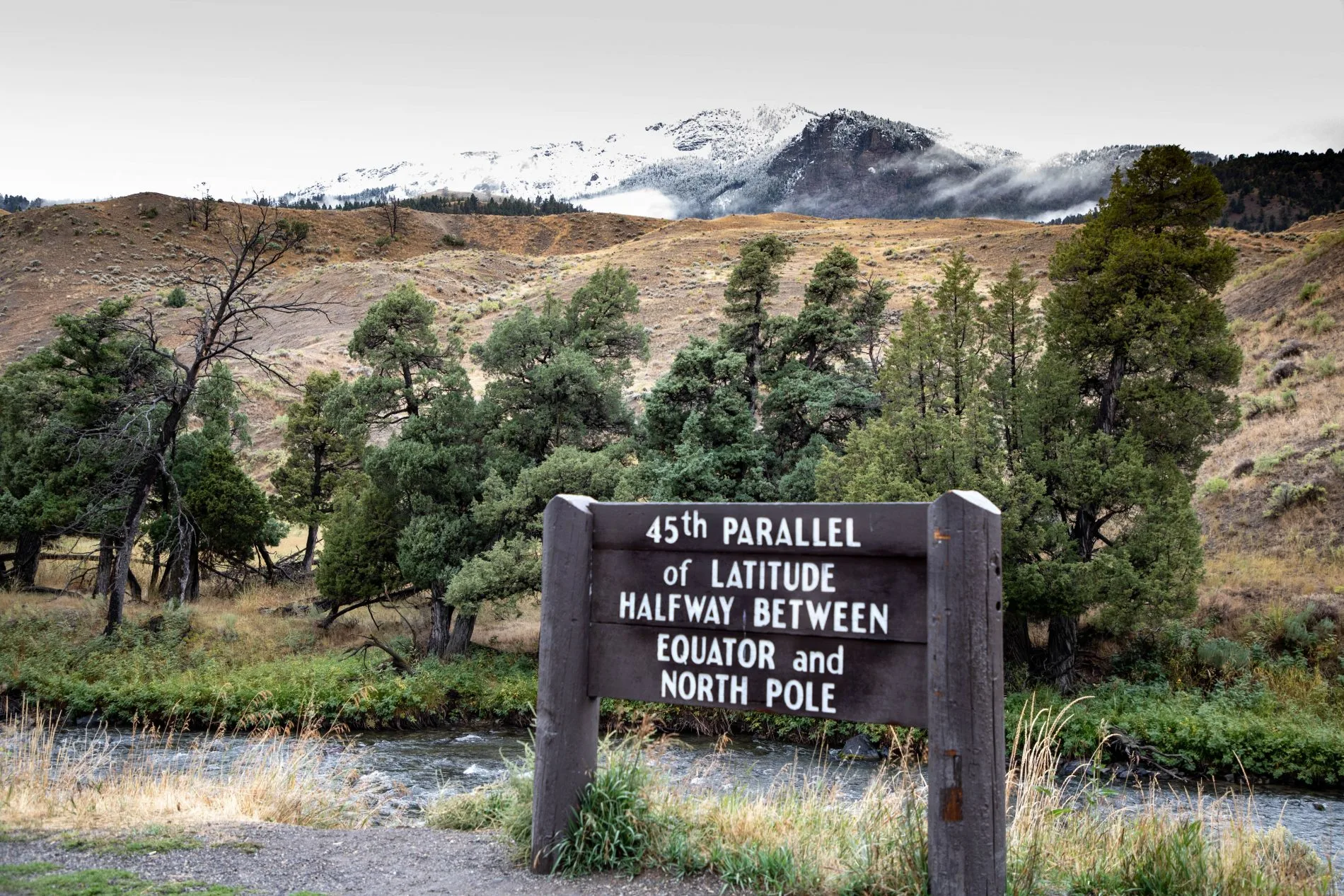
How We Got to Yellowstone
Corinne and I were in Billings for a travel content creators conference and drove from there to Yellowstone (many of the photos are Corinne’s). Our original plan was to take the Beartooth Highway, but it snowed and the Beartooth road was closed. So, we took the Chief Joseph Scenic Byway instead, and it turned out to be a really nice and very scenic alternative.

We entered Yellowstone National Park through the Northeast Entrance (near Cooke City) and traveled through the Northern Range to Mammoth Hot Springs and beyond. Along the way, we passed through Lamar Valley and made a short side trip to Tower Fall.
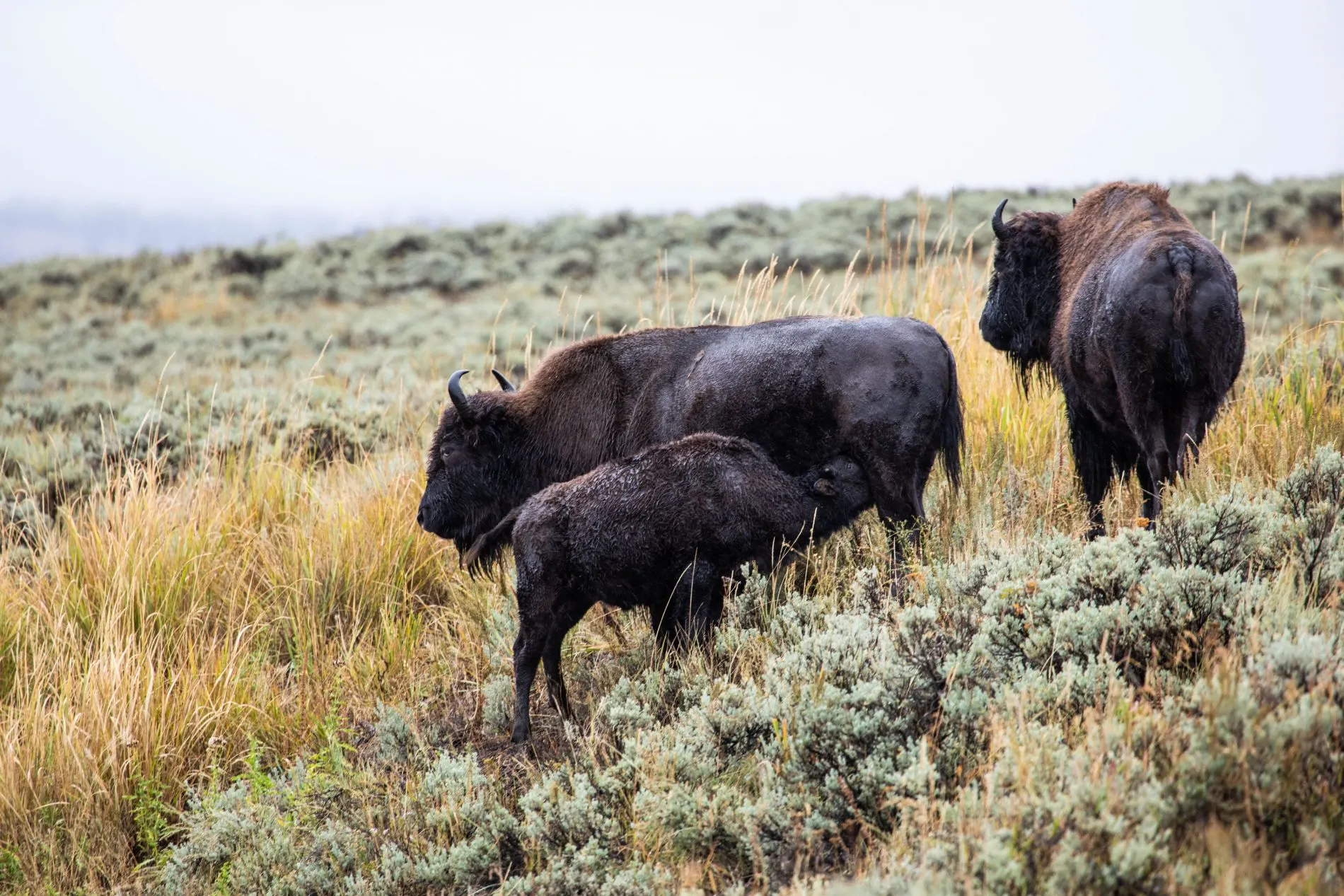
Lamar Valley, the American Serengeti
The 48-mile route from the Northeast Entrance to Mammoth Hot Springs goes through the Lamar Valley where the Lamar River winds through meadows and wetlands. Beyond the narrow valley there are low hills and then mountains.
The valley is great habitat for many animals; the grazers come for the flora; the carnivores come for the grazers. In their video Yellowstone InDepth: The Northern Range, the National Park Service refers to the Lamar Valley as the American Serengeti.
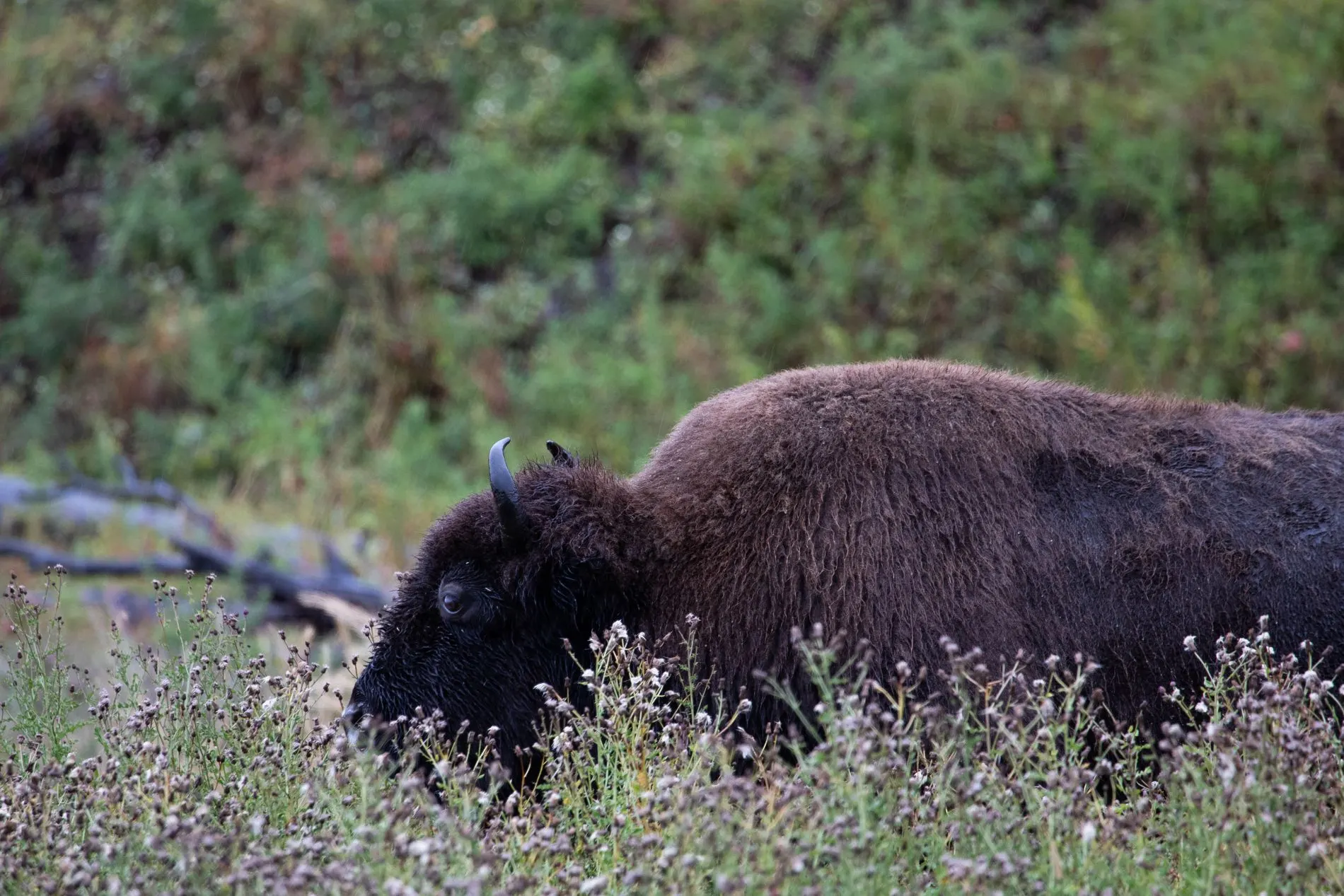
There are deer, pronghorn, hundreds of bison, and thousands of elk. There are also grizzly and black bears, cougars, and wolves. Now that the wolf population has been restored and helped correct the over population of elk, willow and aspen trees are recovering along the river — creating habitat for moose, beaver, and more.
Because there are so many animals in the area and the terrain is flatter and more open, the Lamar Valley is the best place in the park for wildlife viewing. It’s also the best place in the world to see wolves. I could have spent a whole day just in Lamar Valley taking photos and video of the abundant wildlife.
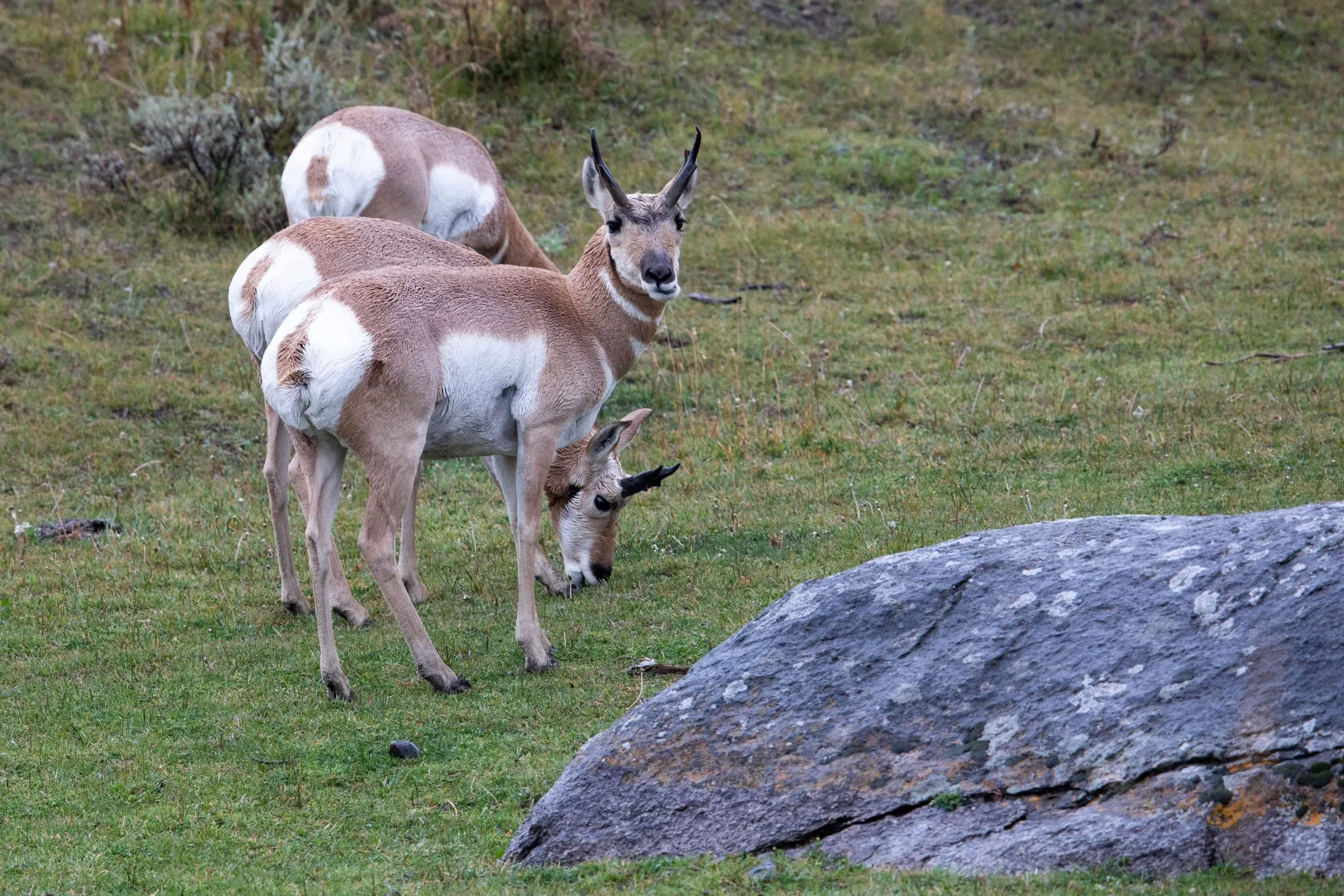
Yellowstone Wildlife Sightings
In our quick trip, we saw a lot of bison and pronghorns, and, in the area around Mammoth Hot Springs, there were elk everywhere.
According to the Yellowstone National Park website there are “nearly 300 species of birds” and “67 species of mammals” in the park as well as a variety amphibians, fish, and reptiles.
The road across Yellowstone’s Northern Range from the Northeast Entrance to Mammoth Hot Springs is the only route kept open for automobile traffic during the winter. And because the animals really stand out on the snowed-covered ground, it is prime wildlife viewing in winter.
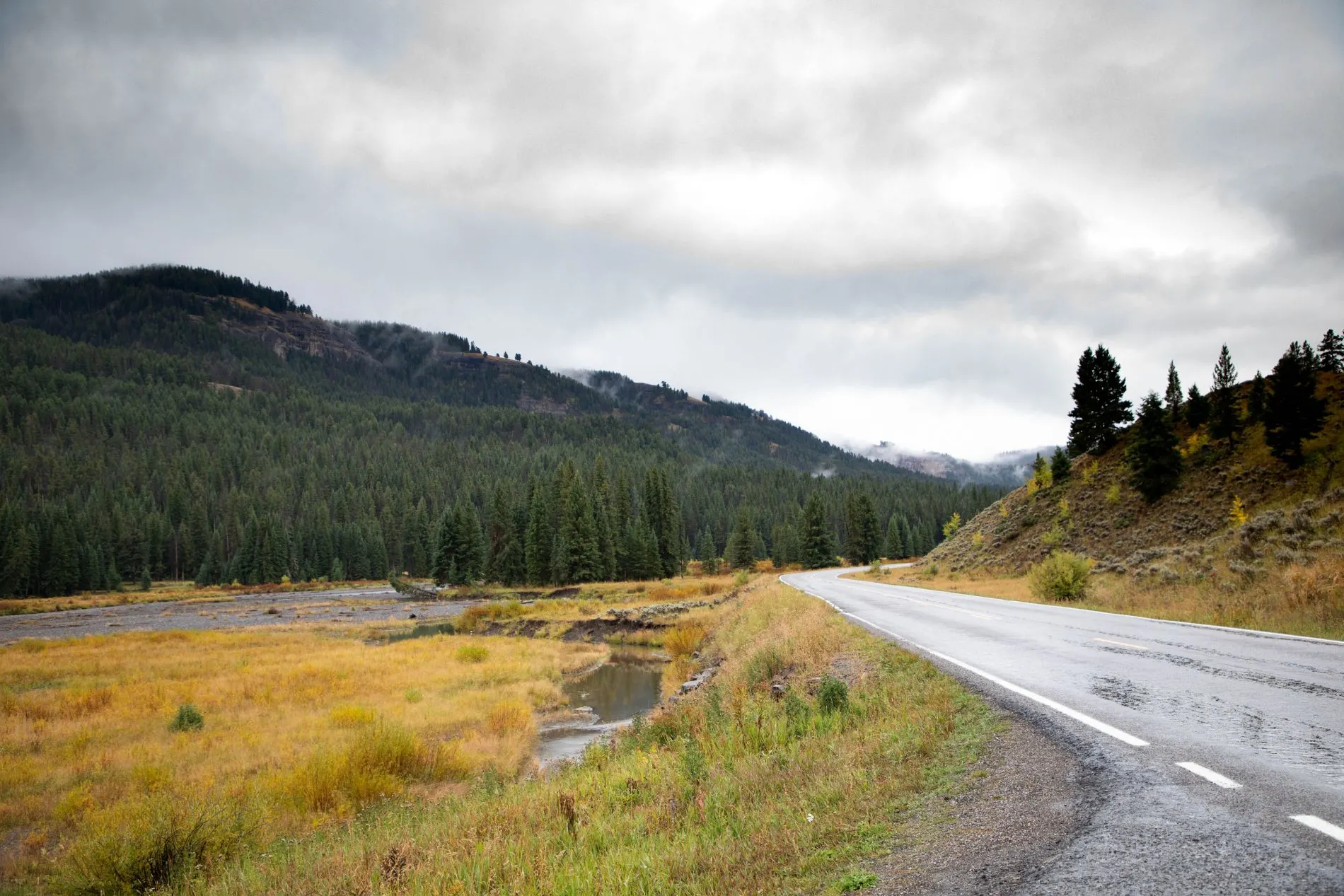
Wolves in Yellowstone
While driving across the Northern Range, we saw cars parked and people along the road with spotting scopes or cameras with ginormous telephoto lenses. We stopped to see what was going on and learned they were watching wolves.
Wolf spotting has become a really big deal in Yellowstone with people coming from all over the United States and from around the world. Winter is the best time for wolf watching because they are much more visible on snow.
Wolves were reintroduced into Yellowstone in 1995 and, since then, the number in the park has grown and stabilized. Inside the park, there are about 100 wolves in ten wolf packs.
The return of wolves to Yellowstone Park has had two big and unexpected benefits:
- Without wolves to help control their populations, the elk and deer were destroying habitat needed by other species. Now the aspen and willow habitat is recovering and other species, like beavers and moose, are returning.
- It has significantly increased the number of visitors to Yellowstone in winter; which brings in more tourist dollars and helps maintain the park.
For more about Yellowstone’s wolves, visit the Yellowstone National Park Gray Wolf website and read or watch CBS 60-Minutes: The Return of Wolves to Yellowstone Park.
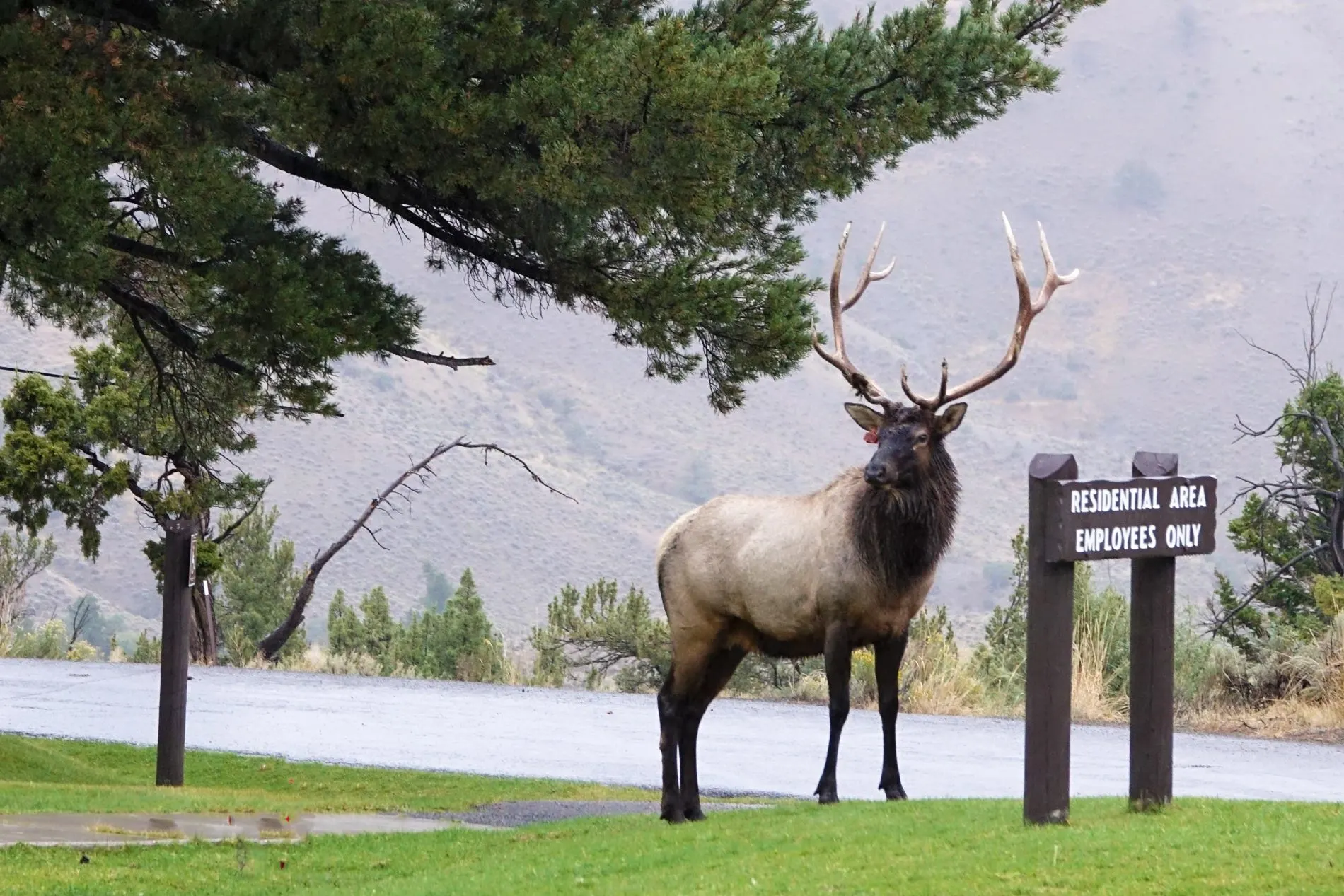
Bugling Elk in Yellowstone
September to mid October is elk mating season in Yellowstone and bugling is part of the elk rut. The males really put on a show. Their bugling is quite dramatic to both see and hear, and it’s reason enough to visit Yellowstone in September.
Mammoth Hot Springs is home to a herd of elk. They are everywhere, and they roam around like they own the place.
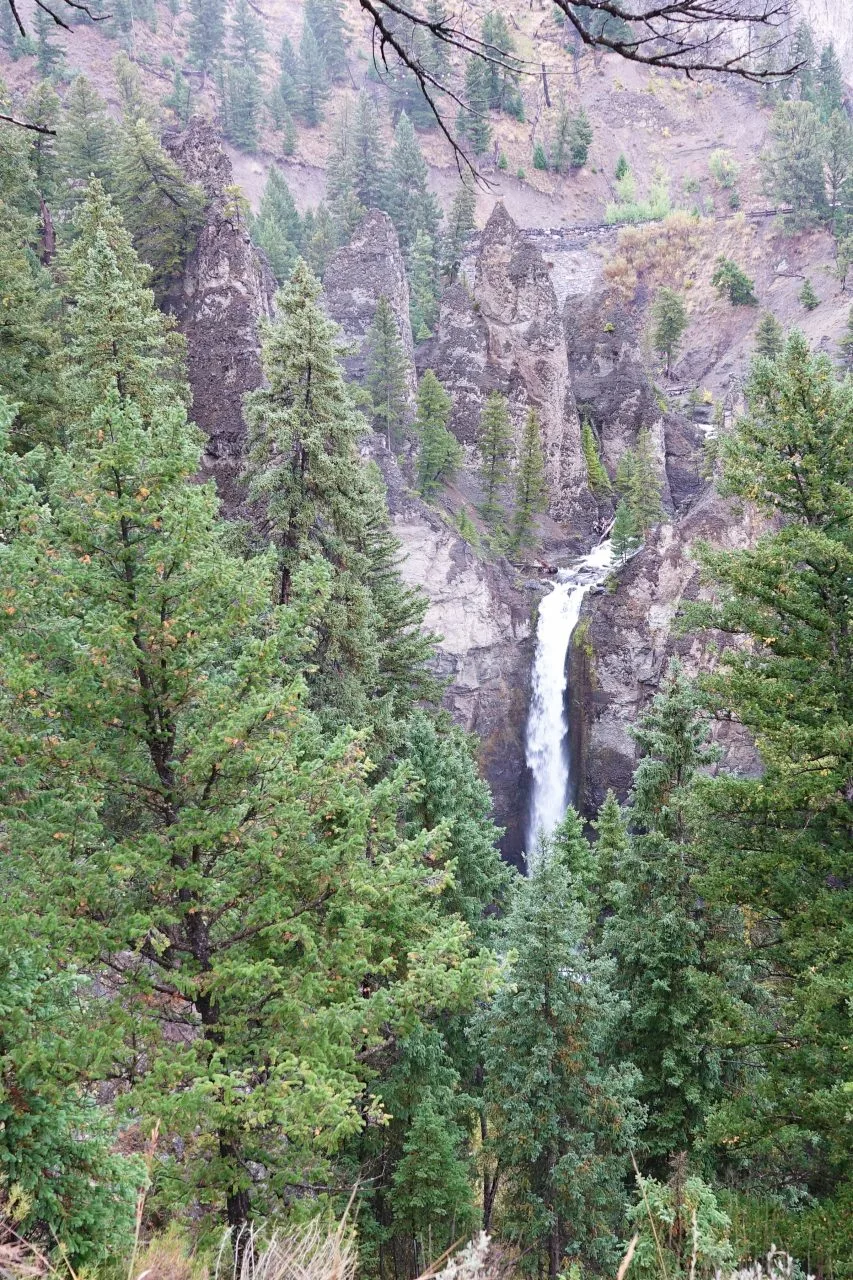
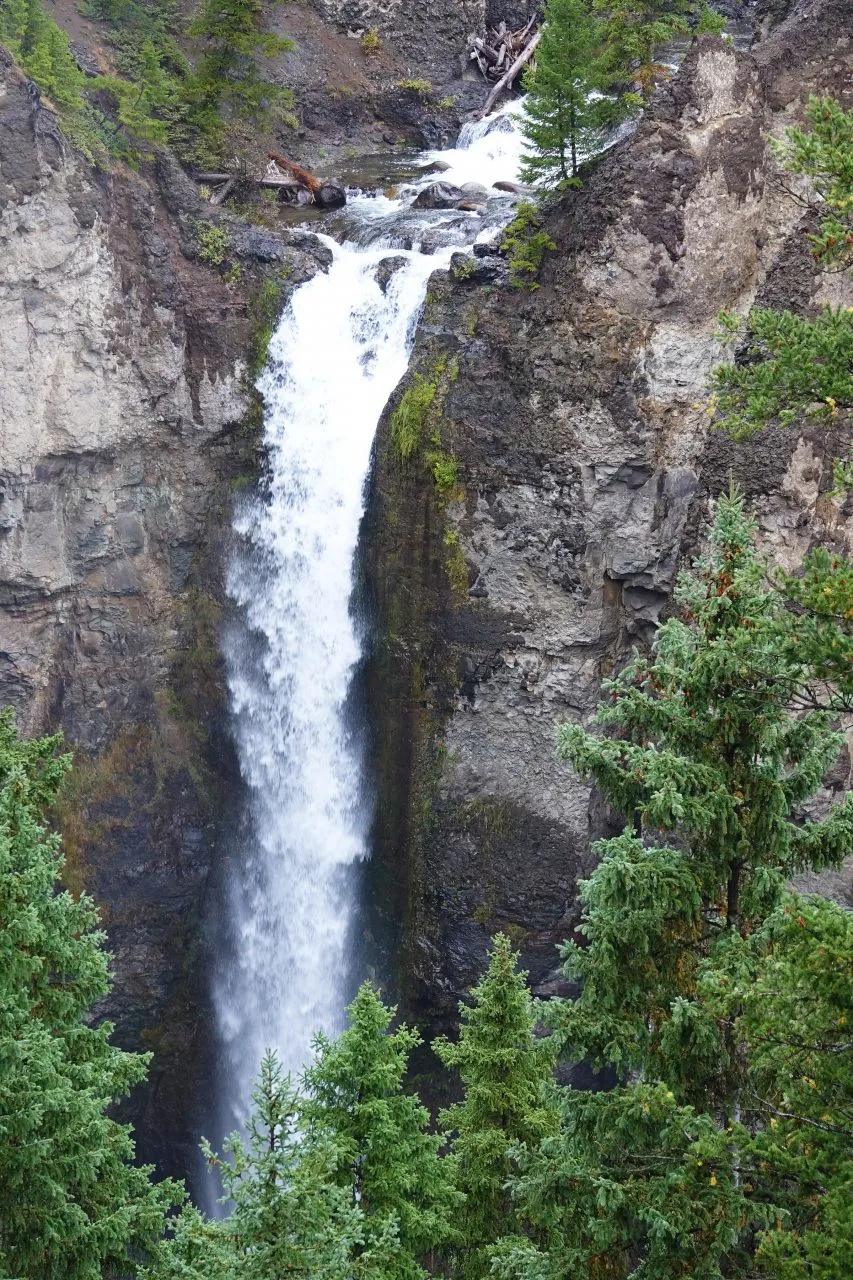
Tower Fall
Tower Fall is one of Yellowstone’s most spectacular and easily viewable waterfalls. It is one of the things to do in Yellowstone with kids. The 132-foot fall is on Tower Creek just before the creek joins the Yellowstone River. It’s one of the sights that impressed members of the United States Congress so much that they established Yellowstone National Park in 1872.
The Fall is named after the cluster of rock towers at the top. These pinnacle-like towers are created by wind and water, which erode the softer rock and soil faster than the harder volcanic rock.
Tower Fall is located on Tower Canyon Road about 3 miles south of Tower-Roosevelt Junction. From the Tower Fall parking lot, it’s a short walk to Tower Fall Overlook where you have a great view of the upper part of the falls and the pinnacles at the top. The 150-yard path is easy and accessible.
There is also a longer path leading down to the Yellowstone River at the bottom of the canyon. You can see the river, but you can no longer see or get to the bottom of the falls. A few years ago, a rockslide destroyed the trail and viewing platform.
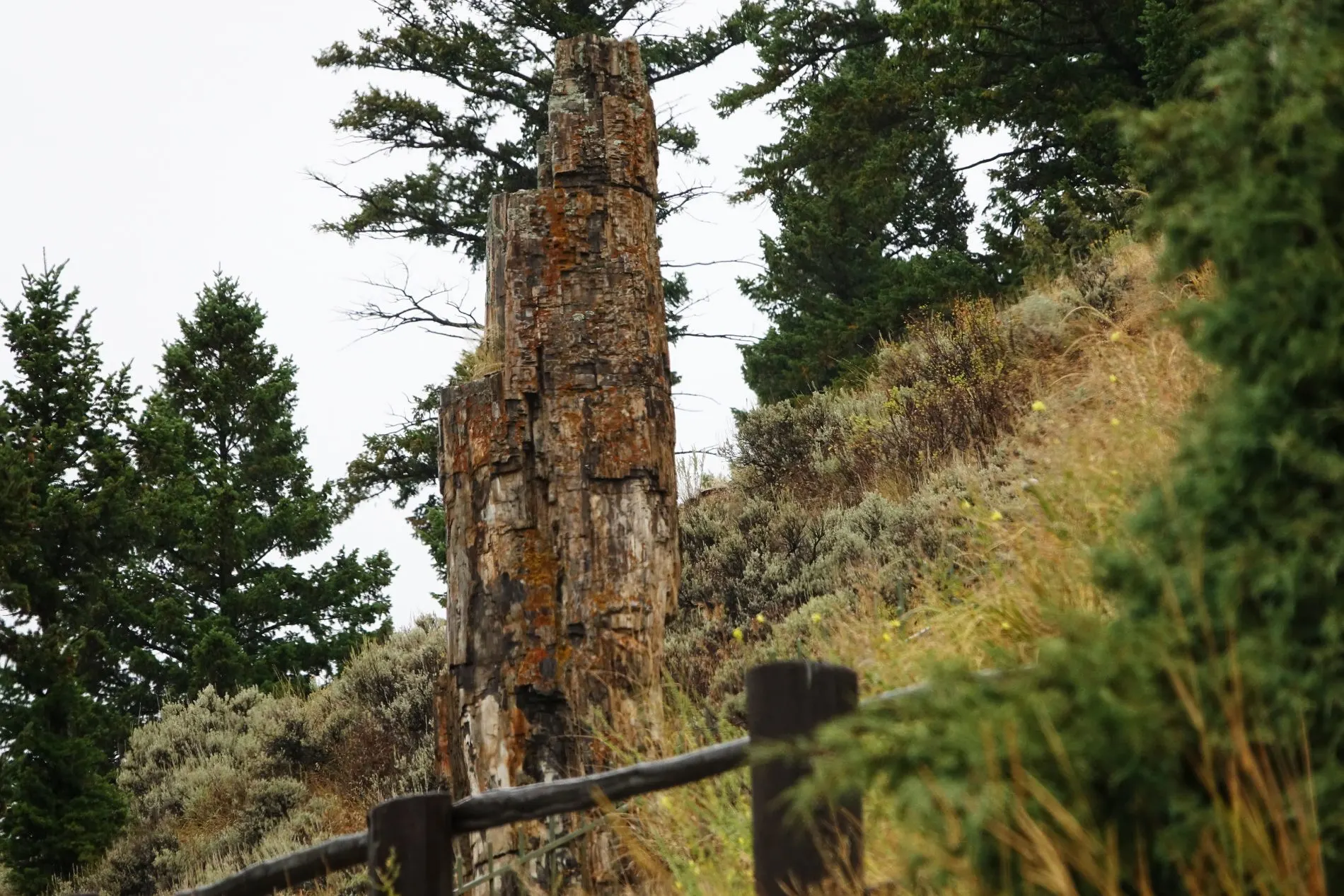
Petrified Tree
Fifty million years ago the Absaroka Volcanoes were so active, their heat melted the snow on the peaks creating mud and debris slides that buried much of Yellowstone’s Northern Range. Entire forests were covered and petrified. Specimen Ridge, east of Tower-Roosevelt Junction, has the largest concentration of fossilized forests in the world.
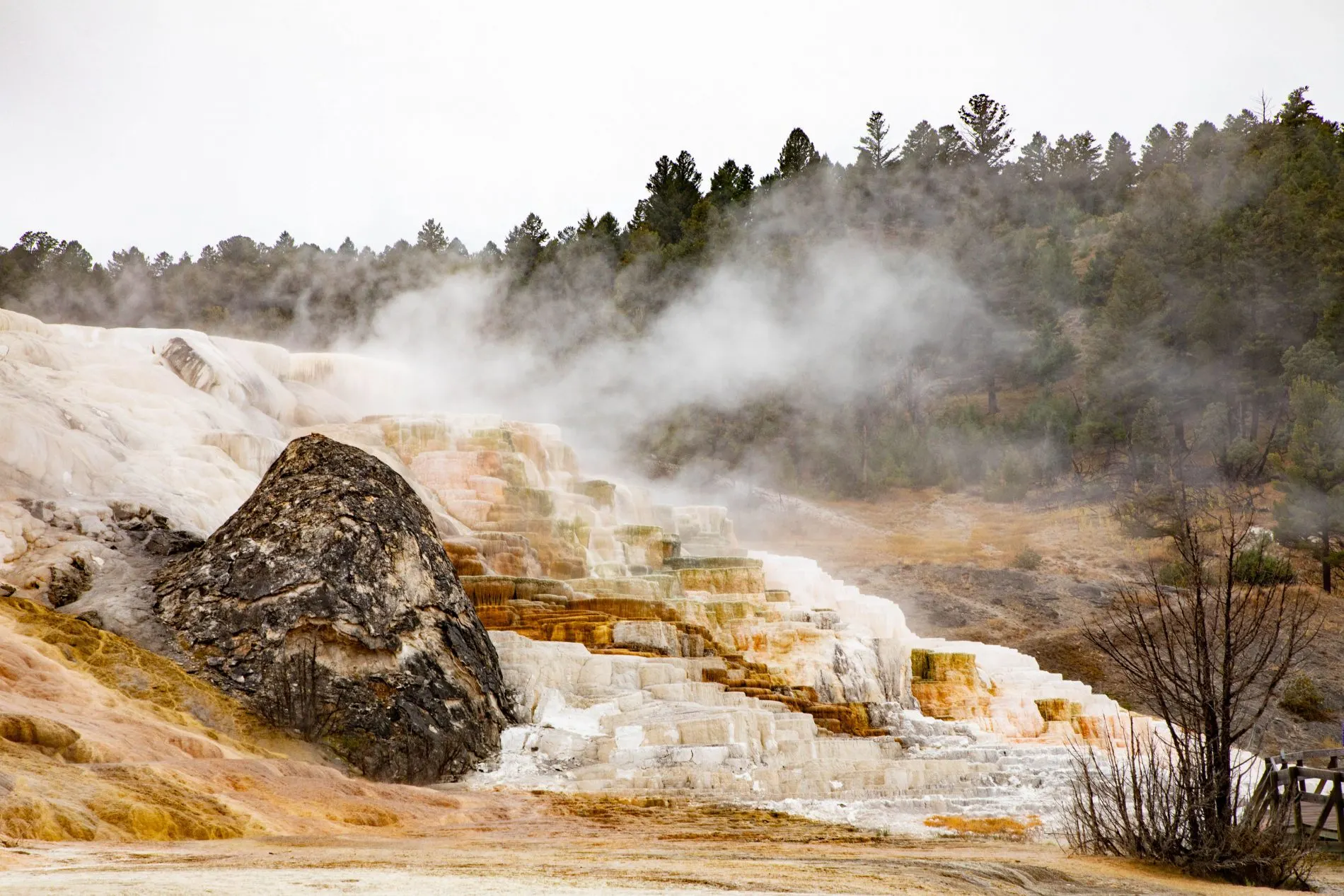
Mammoth Hot Springs
The hot springs are more than enough reason to visit Northern Yellowstone, and they are among the top places to visit in the park. The Historic District in Mammoth is also where the National Park Headquarters and Albright Visitor Center are located.
Mammoth Hot Springs Terraces
The Terraces at Mammoth Hot Springs are a must-see sight in Yellowstone. They are enormous, surreal, and uniquely beautiful. There are two boardwalks, which allow visitors to walk near and in some places over the terraces:
- Access the lower boardwalk from the parking lot or Grand Loop Road.
- Access the upper boardwalk from Upper Terrace Drive, a one-way road.
The terraces are made of travertine, a form of stone created when underground hot springs percolate up through limestone. The rising hot water dissolves calcium carbonate in the limestone and deposits calcite on the terrace surfaces. The terraces are shaped by the way the slow-moving water deposits minerals on the surface; the colors come from bacteria and algae.
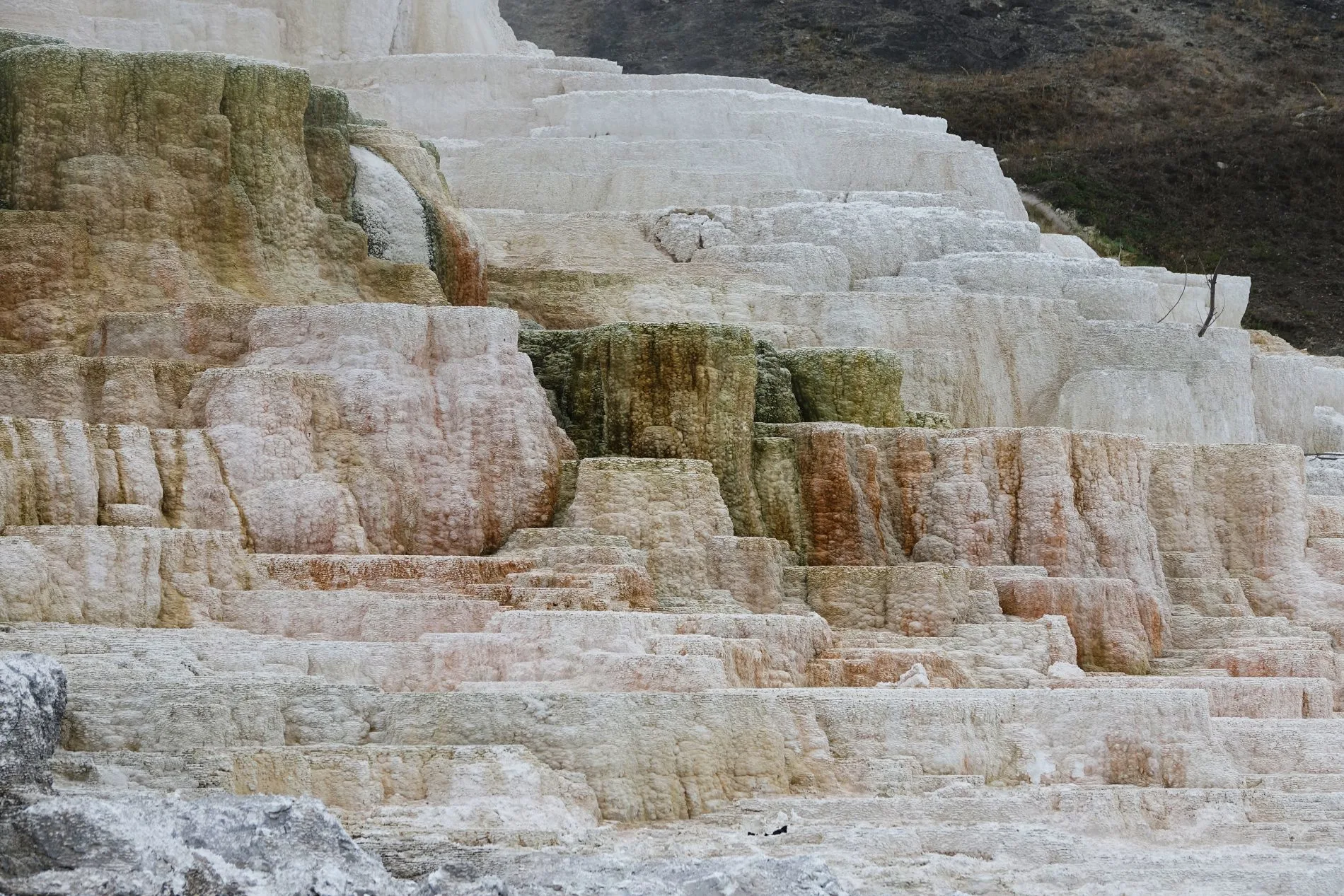
Mammoth Hot Springs Historic District
The small village of Mammoth Hot Springs is next to the terraces. It looks like a small town, but it’s actually the Yellowstone National Park Headquarters. The Albright Visitor Center is located here and provides park information and has history and wildlife exhibits.
Many of the red-roofed buildings in Mammoth are part of historic Fort Yellowstone and date back to 1886. Mammoth Hot Springs also has a hotel and post office.
The terraces and hot springs are located just south of the Northern Entrance to Yellowstone National Park. The Northern Entrance is actually in the small town of Gardiner, Montana just across the Wyoming border.
Firehole Lake Drive
Firehole Lake Drive winds around a string of springs, geysers, mud pots, and Firehole Lake. We missed the Great Fountain Geyser, which only erupts every 8-12 hours, but we saw Pink Cone Geyser in full display. Pink Cone is a beautiful geyser with a tall slender plume. Its eruptions are unpredictable, but they can last a couple of hours.
Firehole Lake Drive is located off of Grand Loop Road halfway between Madison Junction and Old Faithful. It’s a 3-mile, one-way loop.
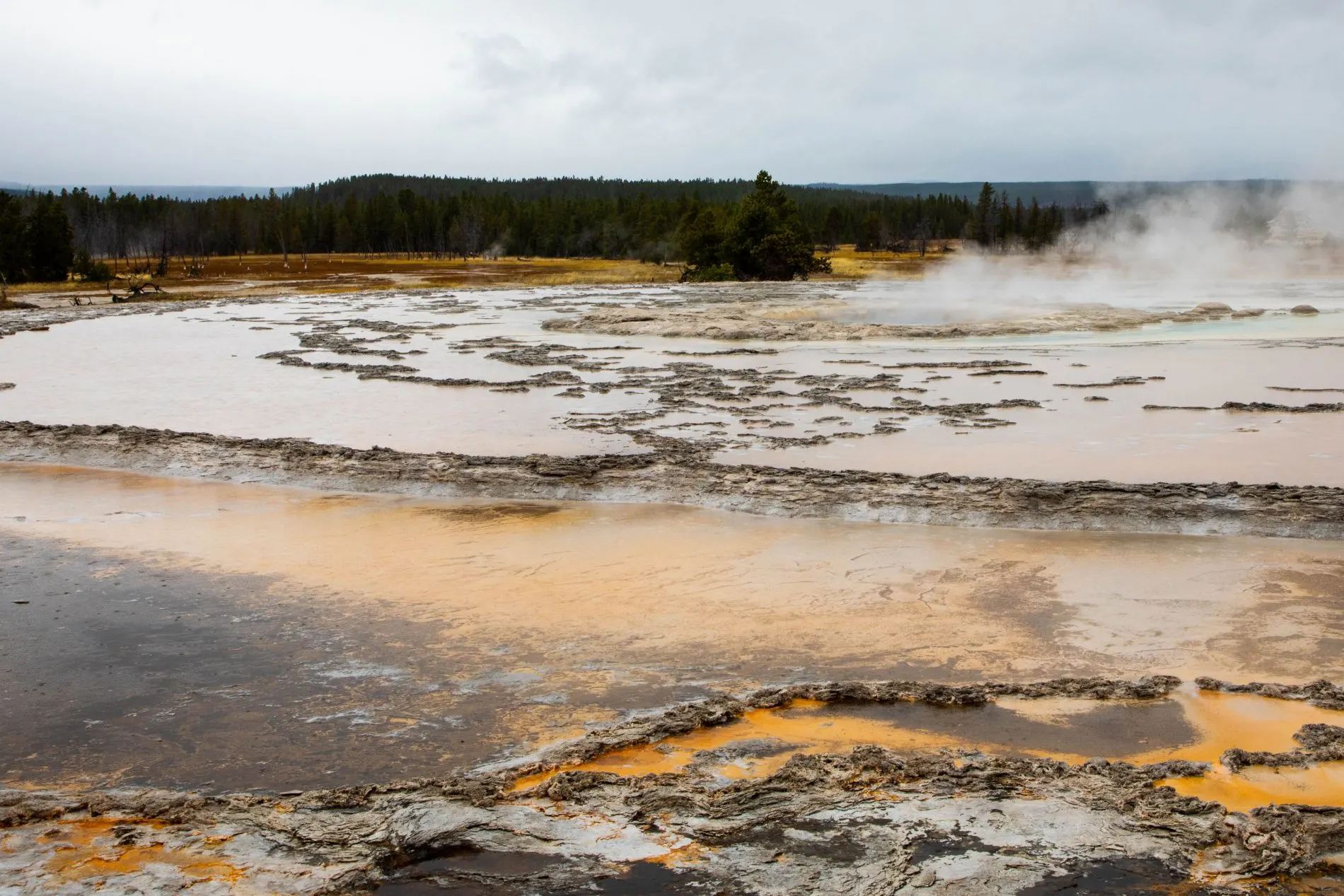
Things We Didn’t Have Time to Do
Even though we limited this visit to the northern part of the park, two-days was not enough. Here’s what we could have seen/done with another couple of days:
In Lamar Valley
- More time watching and photographing wildlife
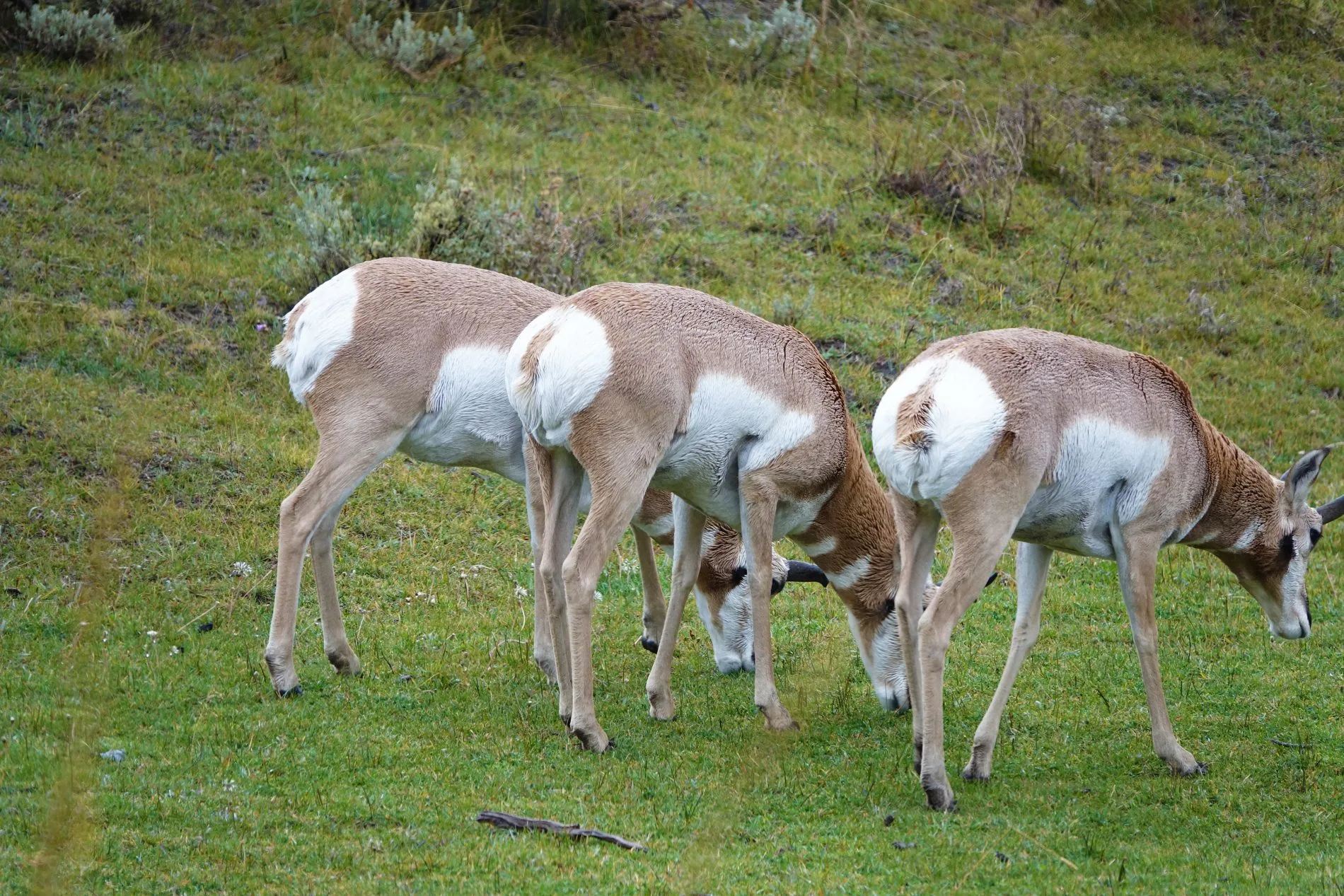
At Tower Fall
- Walk down to the Yellowstone River
At Mammoth Hot Springs
- Albright Visitor Center
- Historic Fort Yellowstone
- Hot Springs Terraces: walk all of the boardwalks
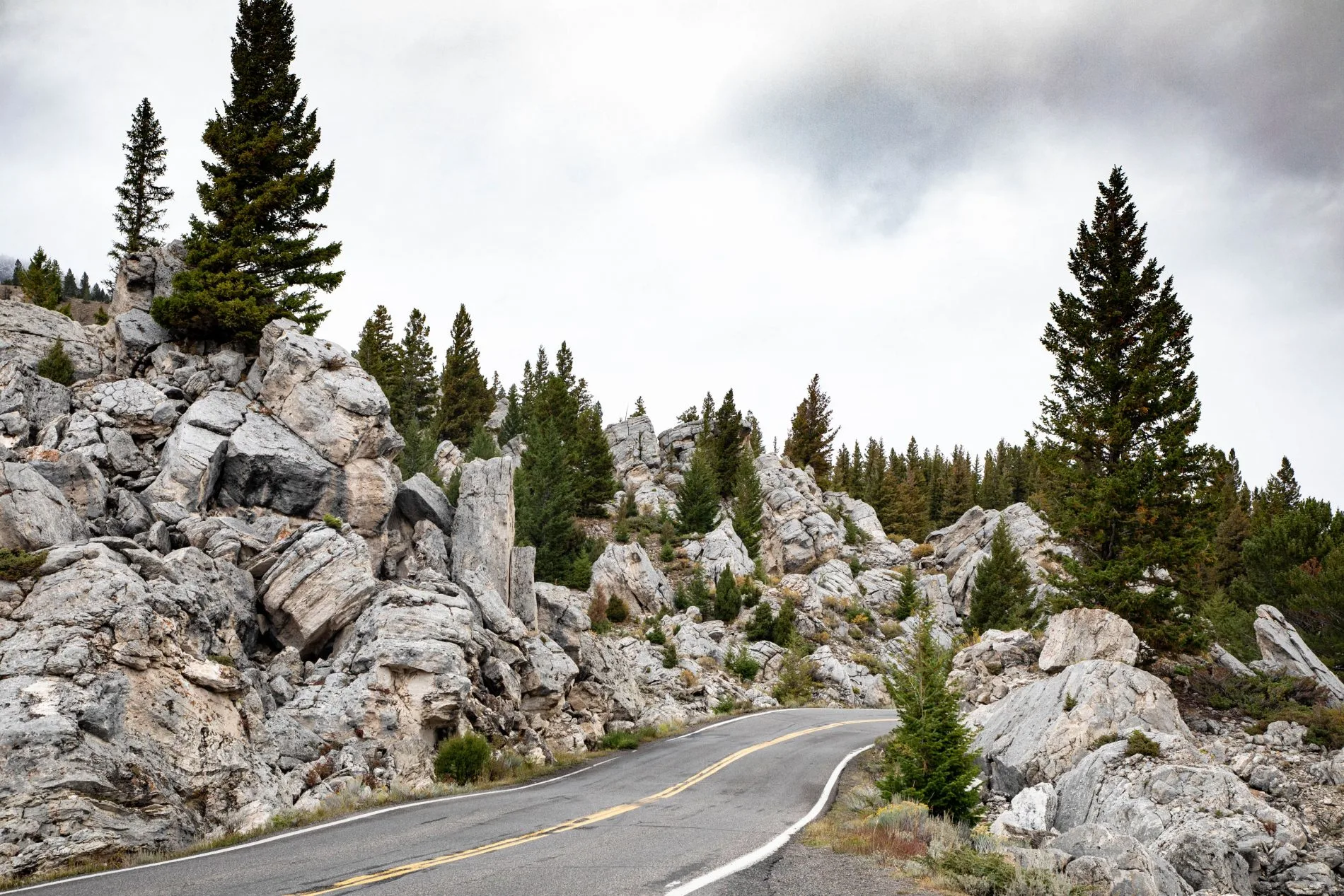
South of Mammoth
- Obsidian Cliff
- Steamboat Geyser near Norris is the world’s tallest currently-active geyser, although eruptions are rare.
- Gibbon Falls drops 84-feet, and in photos on Google images looks like it’s wider than it is high.
- Firehole Canyon Drive
- Grand Prismatic Spring. The parking lot was full, and we simply didn’t have time to wait. The area was also quite steamy so visibility wasn’t ideal for photography.
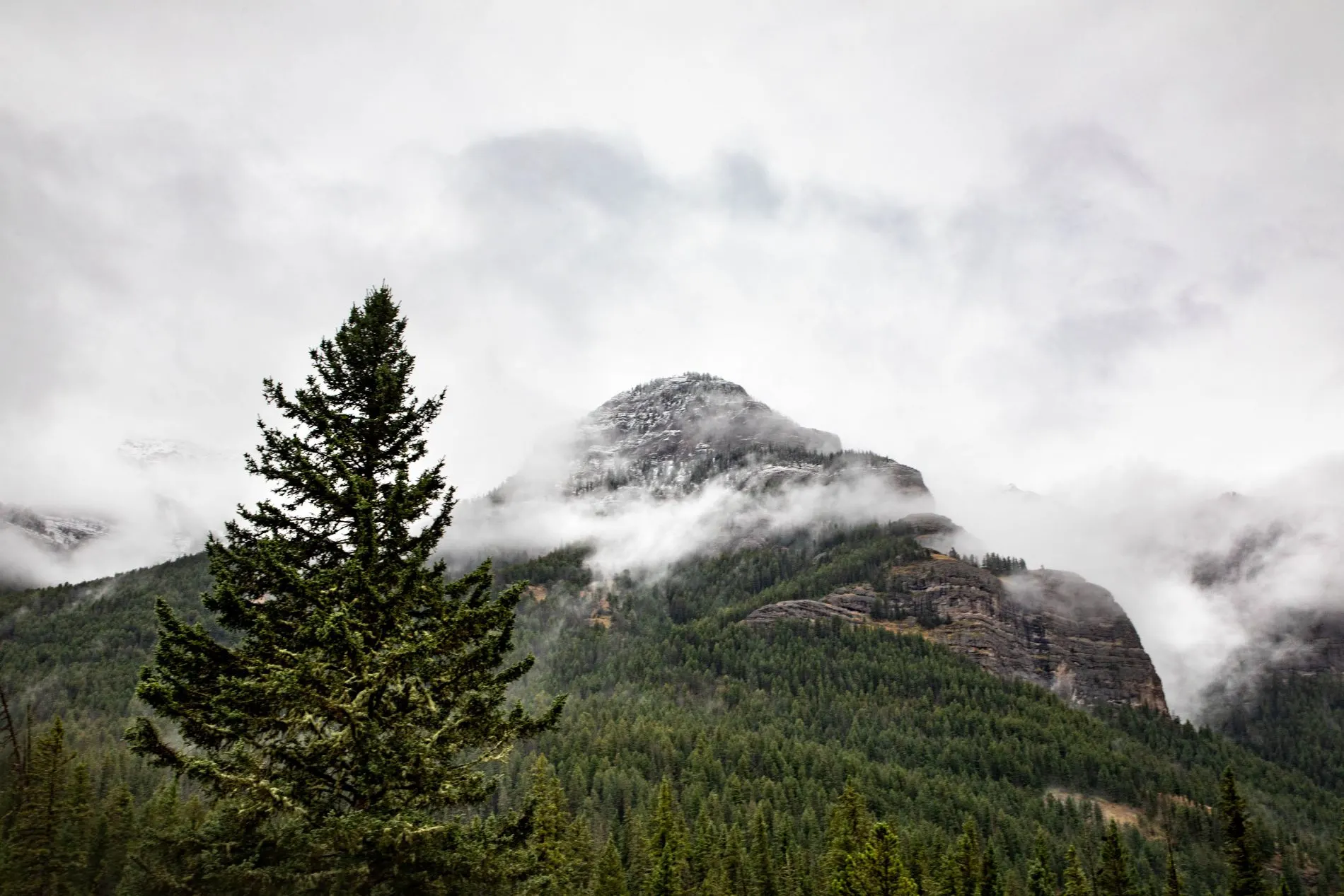
Best Time to Visit Yellowstone
Yellowstone is only fully open in June, July, and August, so check the Yellowstone National Park Operating Hours and Seasons website for specific opening and closing dates. The website has a chart for each park location that lists all sights, services, and businesses.
Yellowstone’s Seasons:
- Summer — Pretty much everything is open and operating in June, July, and August.
- Fall — Parts of the park begin closing in September and almost everything in closed by the end of October.
- Winter — Between early November and late April, the only road open to automobile traffic is the road across Yellowstone’s Northern Range between Gardiner and Cooke City, Montana. Other roads are only open to snowmobiles and snowcoaches. The only businesses open are a few in Mammoth Hot Springs (like the Albright Visitor Center, General Store, and Post Office).
- Spring — It varies by location, but most of the park reopens in April or May.
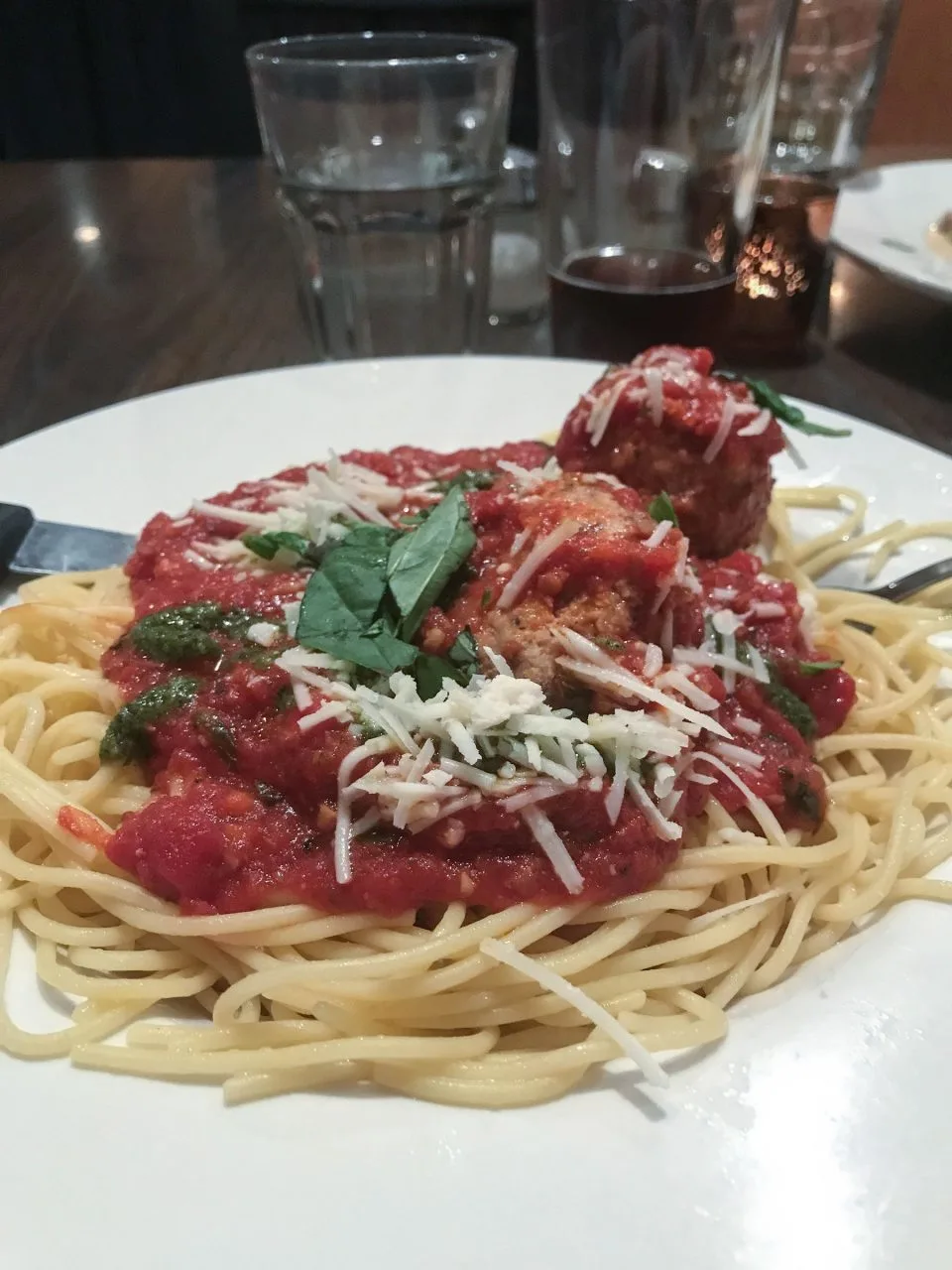
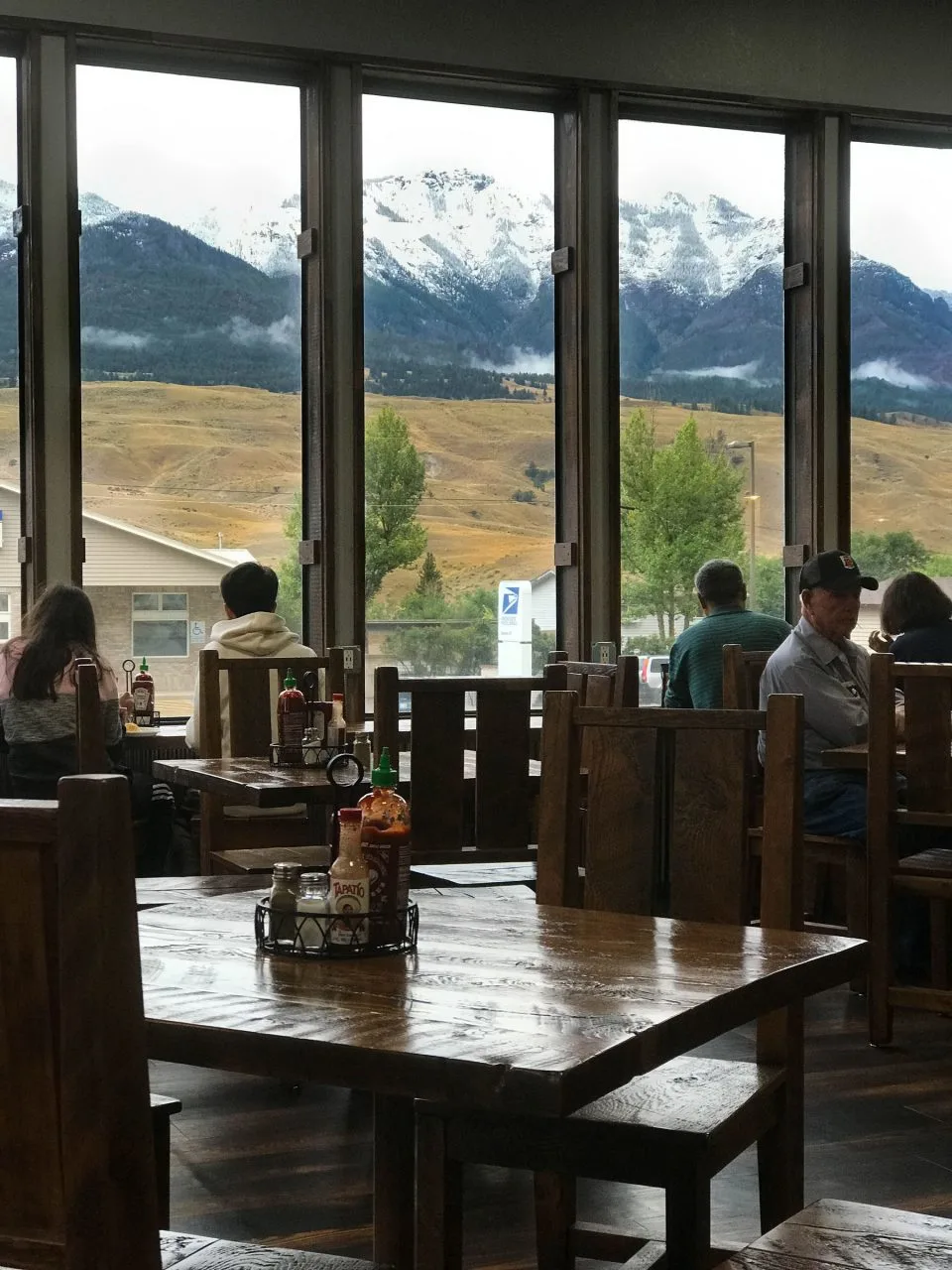
We Ate and Stayed in Gardiner, Montana
We arrived in Gardiner in the early evening without reservations and, although some hotels were full, we quickly got a room at the Yellowstone Super 8. The room was very nice and clean, and the dining area, where breakfast is served, had huge windows with a gorgeous view of nearby mountains. We also had a really nice dinner at The Raven Grill.
Other Places to Stay in Gardiner:
You really can’t go wrong when choosing a hotel in Gardiner. There are many options, and plenty of places to eat in the vicinity. Compare all Gardiner hotels here.
- Yellowstone Basin Inn – Very homey and spacious, good for taking the whole family.
- Yellowstone Village Inn – very clean and breakfast has not stopped during these trying times. An indoor pool.
- Yellowstone Gateway Inn – rooms are very spacious and many have kitchens.
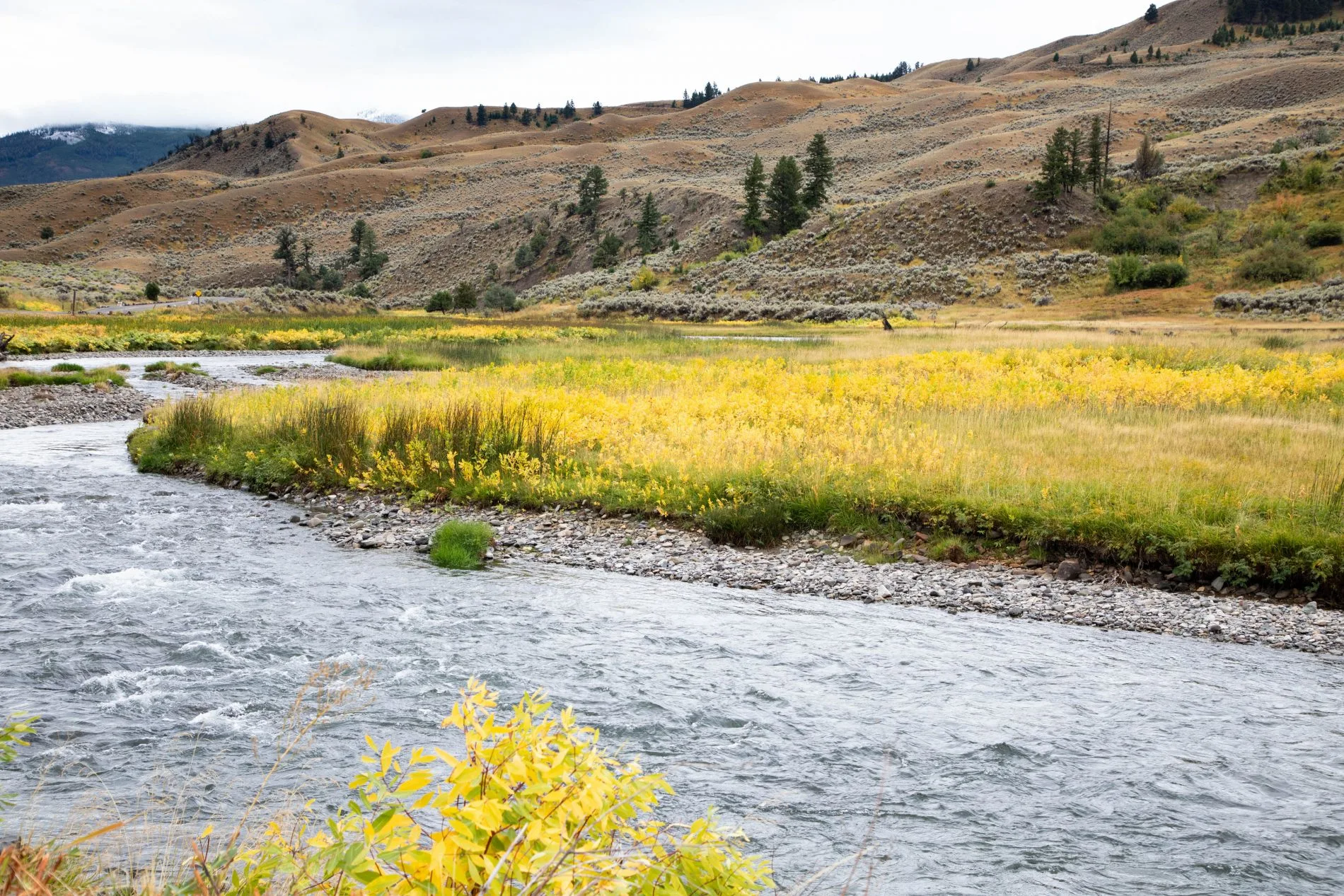
Conclusion
This was a really worthwhile visit to Yellowstone. The only shortcoming is that we didn’t have enough time to see and do as much as we wanted. The intermittent snowy weather was not part of our plan, but it created some beautiful landscapes.
We highly recommend visiting Yellowstone in September. We also recommend spending time in Yellowstone’s Northern Range, especially if you love seeing wildlife in the wild.
When visiting Yellowstone, consider extending your trip and adding one or both of these:
- Add a week and take the amazing Southeast Montana Road Trip
- Add a couple of days and take a boat trip into wild and wonderful Bighorn Canyon. The upper Canyon area shuts down after Labor Day, so if your Yellowstone trip is in September, go to Bighorn first.
About the Author
Ginny Vail is a travel writer who loves travel planning, sightseeing, photography, and videography. She’s visited all 50 states and traveled around the world. Her articles focus on discovering places to go, sights to see, and details about when and how to visit them.
Pin Yellowstone!


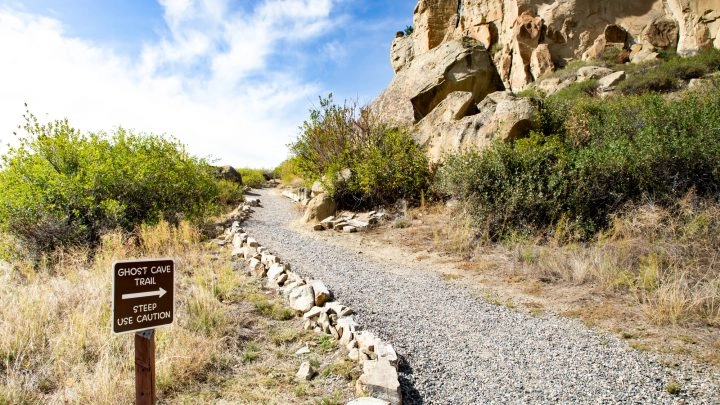
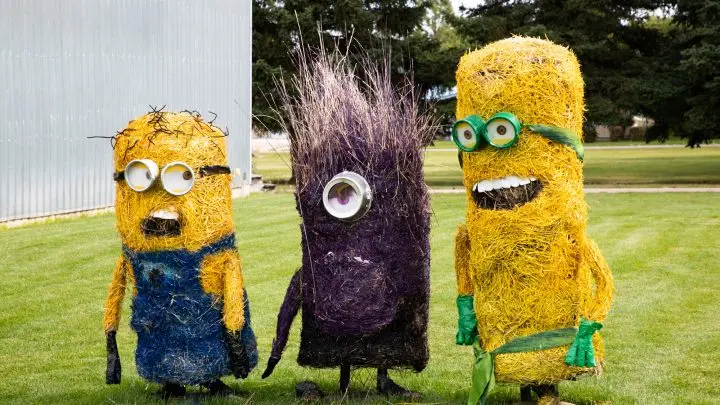
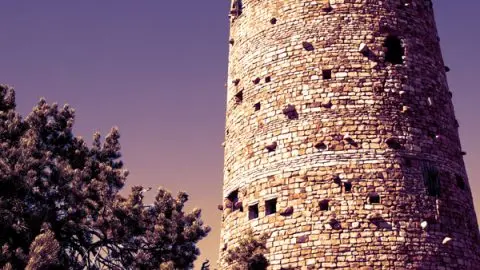
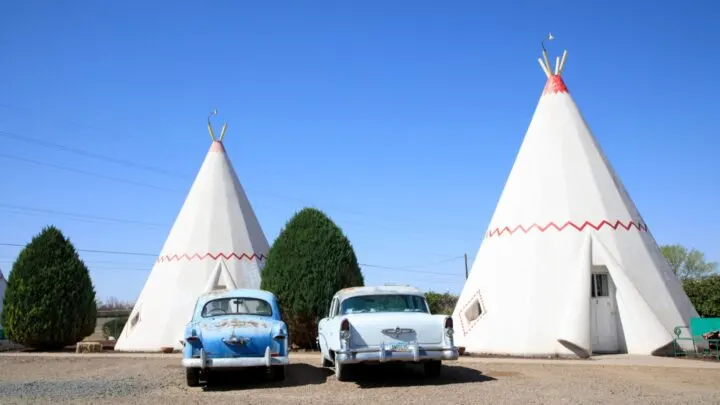
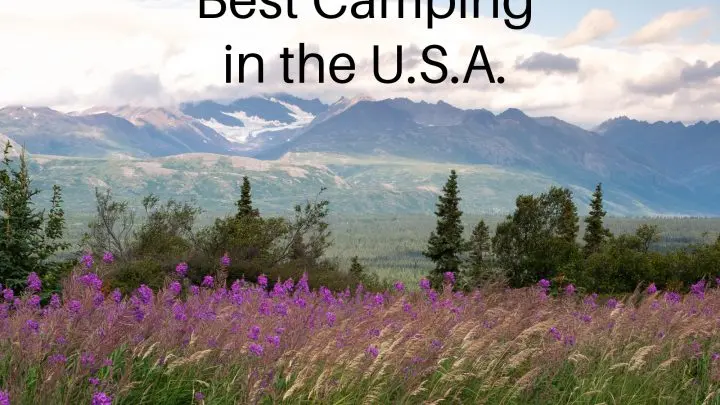
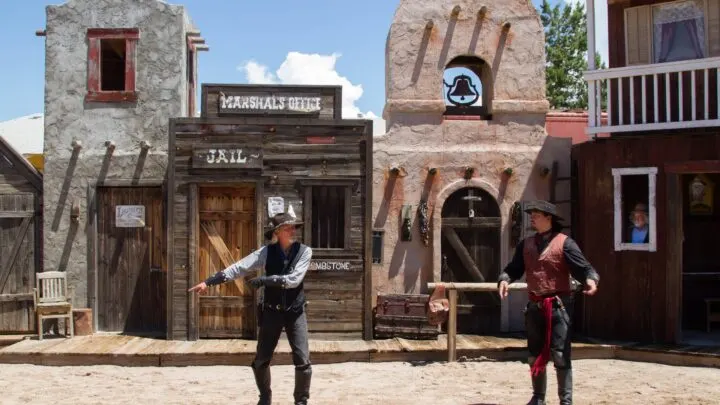
Katherine
Friday 21st of February 2020
There's so much to see in Yellowstone, I feel like I'd need at least a week there to soak it all in! I'd especially like to visit the Mammoth Hot Springs Terraces, and the historic district as well.
Corinne Vail
Saturday 22nd of February 2020
I agree. One week you could probably see most things. However, there are lots of walks to do. Places that are neat around the area, that you could even spend more time than that as well. I love Yellowstone.